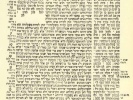
Babylonian Talmud, Book 10: History of the Talmud, tr. by Michael L. Rodkinson, [1918], at sacred-texts.com

Babylonian Talmud, Book 10: History of the Talmud, tr. by Michael L. Rodkinson, [1918], at sacred-texts.com
THE ORIGIN OF THE NAME "TALMUD"--THE SAMARITANS--ANTIOCHUS EPIPHANES--THE SADDUCEES.
The name "written law" was given to the Pentateuch, Prophets and Hagiographa, and that of "oral law" to all the teachings of the "sages" consisting of comments on the text of the Bible. The word Torah alone was applied to the entire Bible, the term "Talmud" was reserved for the oral law, though the meaning of these two words is identical; namely, "teaching" or "study." Still, because it is written Velimdo (Deut. xxxi, 19), and teach it the children of Israel (put it in their mouths; that is to say that the teacher's duty was to explain and comment on the laws and ordinances until the children understood them thoroughly and were conversant with them by heart)--the name "Talmud" was applied to what was styled by a long phrase "Oral Law" (Torah-she b'al-Peh). This word designated all the commentaries of the sages on the Scriptures which the Pharisees had begun to interpret figuratively.
Figurative interpretation was inaugurated in the days of the Great Assembly when its members resolved to keep themselves distinct from the Samaritans, their inveterate enemies, who adhered to the literal interpretation of the text, which, in the opinion of the Pharisees, was falsified by them. This study, however, commenced to make progress at the time of the Sanhedrin, or from that of the Macedonian conquest of Judea, when the term "Great Assembly" was changed to the Greek "Sanhedrin." It spread into every college where were assembled sages entrusted with the guidance of congregations, with instruction of the Law, of ordinances relating to clean and unclean, to property,
to crimes. All sages who interpreted the biblical passages figuratively, unlike the Samaritans, were called "Pharisees." The Samaritans of course persecuted those Pharisees (see App. No. 1), objected to their interpretation, and did them great injury whenever they had the power. At last, Janai, Hyrcanus the First, overcame them, burned their temple, devastated their city, and compelled them by force of arms to conduct themselves according to the doctrines of the Pharisees, though he himself in his latter years became a Sadducee.
Until the time of Antiochus Epiphanes, before which period all the high priests since the erection of the second temple had been of the family of Zadok, King David's high priest (see App. 2), and the priests had been also among the sages of the Pharisees and no disputes arose between them as to the interpretation of the law. From the time of Antiochus, however, when the high priesthood passed from the descendants of Zadok to other families, finally coming into the possession of the Maccabees, who were not descendants of the house of Zadok, began to differ from the Pharisees in the interpretation of the Torah, and to explain the texts on the basis of oral tradition. They founded a distinct sect, styled "Sadducees" (after Zadok), and the dispute with the Pharisees and their teaching, i.e. with the Talmud, was begun. They persecuted the Pharisees to the utmost; being mostly men of wealth and rank, and in their hearts leaning toward the Hellenes, who then held sway in Palestine, they joined the Samaritans, the foes of the Jews, whose aim was to eradicate the study of Judaism. Thus united, they gave their aid to Antiochus Epiphanes, who was anyhow the enemy of the Jews, and who decreed on the pain of capital punishment that the Pharisees should discontinue their studies, that circumcision should be performed in a manner other than that prescribed by the Pharisees (see App. No. 3); that the Sabbath should not be observed according to the interpretation of the Sabbath law by the Pharisees, etc. The obvious intention was to destroy the Talmud together with Pharisees who adhered to it. These persecutions against the Talmud ended usually in favor of the Sadducees until the time of Simon ben Shetah, and the above mentioned Janai, Hyrcanus I. (Johanan the High Priest). Then the Pharisees triumphed over their foes, and the oral law was the absorbing subject of the Sanhedrin, under the
leadership of Joshuah b. Prachia, Simon b. Shetah and Jehudah b. Tabai. The Talmud was then studied in all colleges of Palestine, Egypt and wherever Jews lived. Owing to the enmity of the Samaritans and the opposition of the Sadducees, many laws and regulations were added to the Talmud of the Pharisees. From that time the Pharisees began to restrict their interpretations so as to make them agree with the deep though literal meaning of the texts, employing therein much sophistry. They counted all the letters of the Torah, and if they found a word or letter not absolutely necessary to the understanding of the text, they said it was placed there only to add to or subtract from the meaning. But at that period the Mishna was not a separate and distinct thing from the Talmud, though many ancient Mishnas already existed in writing, but without a separate title. The Pharisees studied the ancient Mishnayoth, added (see App. No. 4) to them, and explained the biblical texts. All this was entitled Oral Law, or, shortly, "Talmud."